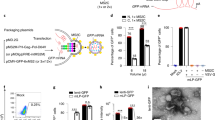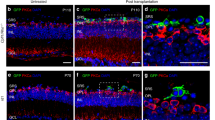Abstract
Gene transfer offers a substantial promise for the therapy of degenerative ocular diseases. Lentiviral vectors have the ability to efficiently transduce murine photoreceptors during the first days of life, but they are poorly effective on photoreceptors during adulthood. Here, we studied whether a physical barrier was responsible for this impairment. Previous studies have described the capacity of enzymes, such as chondroitinase ABC and neuraminidase X, to modify the structure of the interphotoreceptor matrix (IPM) when subretinally injected. Considering the IPM as a physical barrier that may decrease photoreceptor transduction, we injected different enzymes into the subretinal space of the adult mouse simultaneously with the lentiviral vector preparation, to increase viral transduction by fragilizing the IPM. Subretinal injection of neuraminidase X and chondroitinase ABC induces modifications in the IPM by, respectively, revealing or decreasing peanut agglutinin sites on photoreceptors. The simultaneous subretinal injection of neuraminidase X with a lentiviral vector driving the expression of a reporter gene in the photoreceptors increases the number of transduced cells significantly (around five-fold). After the enzyme treatment, the diffusion of the vector between the pigmented epithelium and the photoreceptors appears to facilitate the lentiviral vector transduction. Such approach targeting the IPM may help to design new strategies to improve gene delivery into the adult photoreceptors.
This is a preview of subscription content, access via your institution
Access options
Subscribe to this journal
Receive 12 print issues and online access
$259.00 per year
only $21.58 per issue
Buy this article
- Purchase on Springer Link
- Instant access to full article PDF
Prices may be subject to local taxes which are calculated during checkout




Similar content being viewed by others
References
Rivolta C, Sharon D, DeAngelis MM, Dryja TP . Retinitis pigmentosa and allied diseases: numerous diseases, genes, and inheritance patterns. Hum Mol Genet 2002; 11: 1219–1227.
Cremers FP, van den Hurk JA, den Hollander AI . Molecular genetics of Leber congenital amaurosis. Hum Mol Genet 2002; 11: 1169–1176.
Miyoshi H, Takahashi M, Gage FH, Verma IM . Stable and efficient gene transfer into the retina using an HIV-based lentiviral vector. Proc Natl Acad Sci USA 1997; 94: 10319–10323.
Takahashi M, Miyoshi H, Verma IM, Gage FH . Rescue from photoreceptor degeneration in the rd mouse by human immunodeficiency virus vector-mediated gene transfer. J Virol 1999; 73: 7812–7816.
Ali RR et al. Restoration of photoreceptor ultrastructure and function in retinal degeneration slow mice by gene therapy. Nat Genet 2000; 25: 306–310.
Acland GM et al. Gene therapy restores vision in a canine model of childhood blindness. Nat Genet 2001; 28: 92–95.
Green ES et al. Two animal models of retinal degeneration are rescued by recombinant adeno-associated virus-mediated production of FGF-5 and FGF-18. Mol Ther 2001; 3: 507–515.
Lotery AJ et al. Gene transfer to the nonhuman primate retina with recombinant feline immunodeficiency virus vectors. Hum Gene Ther 2002; 13: 689–696.
Adamus G et al. Anti-apoptotic effects of CNTF gene transfer on photoreceptor degeneration in experimental antibody-induced retinopathy. J Autoimmun 2003; 21: 121–129.
Narfstrom K et al. Functional and structural recovery of the retina after gene therapy in the RPE65 null mutation dog. Invest Ophthalmol Vis Sci 2003; 44: 1663–1672.
Smith AJ et al. AAV-mediated gene transfer slows photoreceptor loss in the RCS rat model of retinitis pigmentosa. Mol Ther 2003; 8: 188–195.
Van Adel BA et al. Delivery of ciliary neurotrophic factor via lentiviral-mediated transfer protects axotomized retinal ganglion cells for an extended period of time. Hum Gene Ther 2003; 14: 103–115.
Ford M, Bragadottir R, Rakoczy PE, Narfstrom K . Gene transfer in the RPE65 null mutation dog: relationship between construct volume, visual behavior and electroretinographic (ERG) results. Doc Ophthalmol 2003; 107: 79–86.
Kostic C et al. Activity analysis of housekeeping promoters using self-inactivating lentiviral vector delivery into the mouse retina. Gene Therapy 2003; 10: 818–821.
Hageman GS, Marmor MF, Yao XY, Johnson LV . The interphotoreceptor matrix mediates primate retinal adhesion. Arch Ophthalmol 1995; 113: 655–660.
Yao XY, Hageman GS, Marmor MF . Retinal adhesiveness is weakened by enzymatic modification of the interphotoreceptor matrix in vivo. Invest Ophthalmol Vis Sci 1990; 31: 2051–2058.
Bennett J et al. Adenovirus-mediated delivery of rhodopsin-promoted bcl-2 results in a delay in photoreceptor cell death in the rd/rd mouse. Gene Therapy 1998; 5: 1156–1164.
Bennett J, Sun D, Kariko K . Sequence analysis of the 5.34-kb 5′ flanking region of the human rhodopsin-encoding gene. Gene 1995; 167: 317–320.
Bainbridge JW et al. In vivo gene transfer to the mouse eye using an HIV-based lentiviral vector; efficient long-term transduction of corneal endothelium and retinal pigment epithelium. Gene Therapy 2001; 8: 1665–1668.
Zhang Y et al. Integration between abutting retinas: role of glial structures and associated molecules at the interface. Invest Ophthalmol Vis Sci 2004; 45: 4440–4449.
Yao XY, Hageman GS, Marmor MF . Recovery of retinal adhesion after enzymatic perturbation of the interphotoreceptor matrix. Invest Ophthalmol Vis Sci 1992; 33: 498–503.
Acknowledgements
We thank Jean Bennett for the gift of the rhodopsin promoter, Meriem Tekaya for the technical support, Dana Hornfeld for the preparation of the manuscript and our colleagues for critical reading of this manuscript. This work was supported by the ProVisu Foundation and by the Swedish Research Council (MTRP: #12209).
Author information
Authors and Affiliations
Rights and permissions
About this article
Cite this article
Grüter, O., Kostic, C., Crippa, S. et al. Lentiviral vector-mediated gene transfer in adult mouse photoreceptors is impaired by the presence of a physical barrier. Gene Ther 12, 942–947 (2005). https://doi.org/10.1038/sj.gt.3302485
Received:
Accepted:
Published:
Issue Date:
DOI: https://doi.org/10.1038/sj.gt.3302485
Keywords
This article is cited by
-
Potential therapeutic strategies for photoreceptor degeneration: the path to restore vision
Journal of Translational Medicine (2022)
-
A comprehensive atlas of Aggrecan, Versican, Neurocan and Phosphacan expression across time in wildtype retina and in retinal degeneration
Scientific Reports (2022)
-
Retinal transduction profiles by high-capacity viral vectors
Gene Therapy (2014)
-
Ocular gene delivery using lentiviral vectors
Gene Therapy (2012)
-
Gene supplementation therapy for recessive forms of inherited retinal dystrophies
Gene Therapy (2012)



